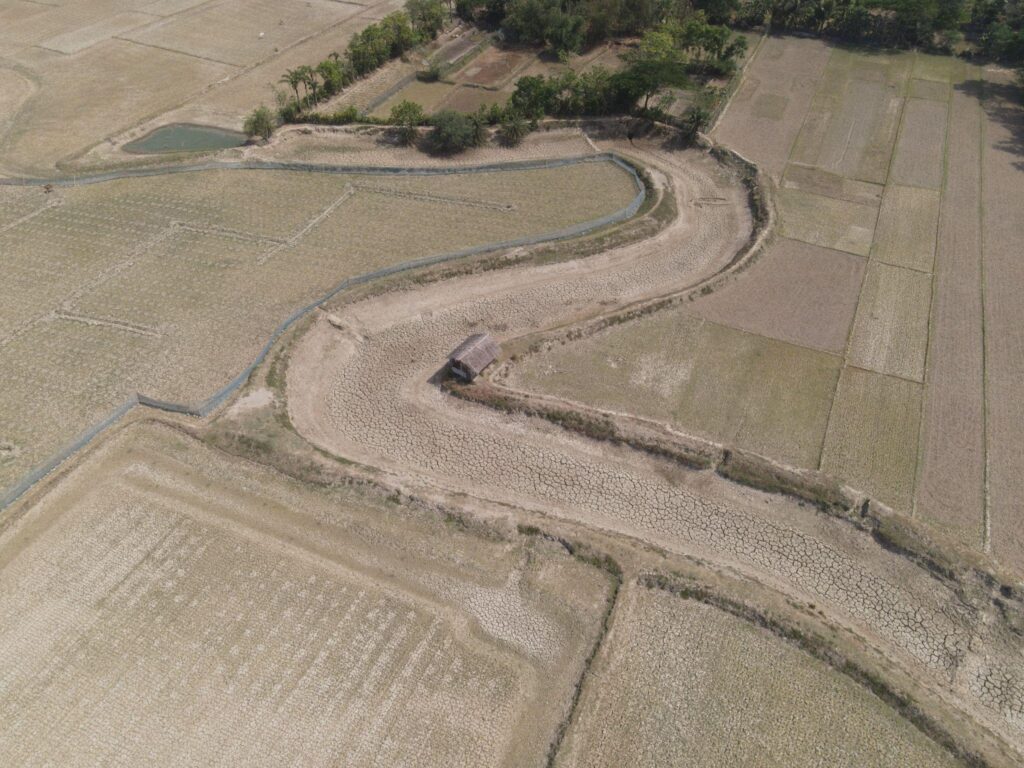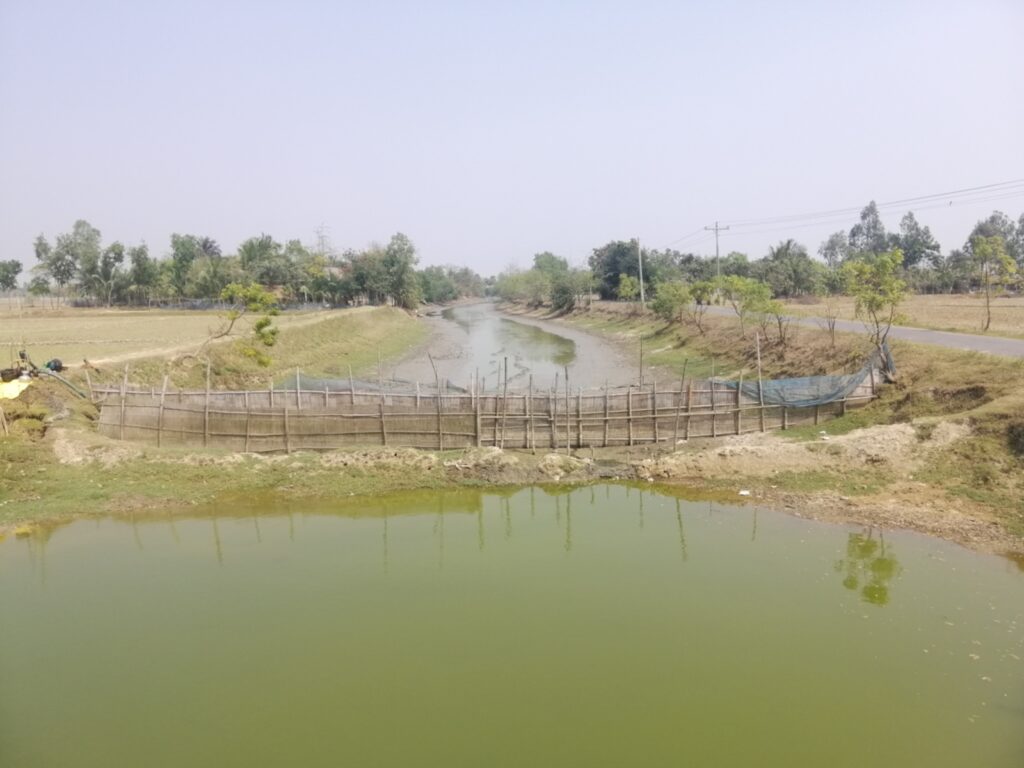by Mou Rani Sarker, Bushra Humaira Sadaf and Ahmad Salahuddin

With around 300 households, Hironpur (pseudonym) in Munshigonj Union in Shyamnagar Upazila, Satkhira is located in southwest Bangladesh. The village is facing significant agricultural challenges. The villagers’ livelihood depends on agricultural production, including vegetable gardening, shrimp farming, cattle raising, and poultry farming.
The community heavily relies on canals, known as khals, for irrigation, drainage, and fisheries. However, a severe water crisis during dry season for agricultural use has turned the once-thriving lands into barren fields during the dry seasons, forcing villagers to seek work elsewhere.
A seasonal struggle
Aman is the primary cropping season in Hironpur because of the ample rainfall that sustains rice cultivation. However, once the aman season ends, water scarcity takes its toll. Although a few farmers attempt to grow vegetables during winter, the water in khals¹ and ponds is insufficient for the crops. The dry season exacerbates this crisis, making irrigation nearly impossible.
“After aman², there’s hardly any water in the canal for farming,” said Rumki Gosh, a 35-year-old female farmer. “That little remains turn saline. We can barely manage two rounds of irrigation. It’s better not to farm than to watch your crops die”
Another farmer added, “As there is water scarcity, we can hardly grow our food. We have no choice but to leave home and search for work outside the village,” said Opu Mondal, another farmer from Hironpur village
Climate stress: A relentless curse
Along with prevalent water scarcity, the village also experiences tidal surges and saltwater intrusion yearly, making water for agricultural use increasingly scarce and unsuitable for farming.
“When cyclones strike, everything is swept away,” Sujan Mia described the devastation in the community caused by natural disasters. We lose our crops, our livestock, even our homes.”
The water crisis worsened after cyclone Aila hit the village in 2009. After Aila, there were no job opportunities, and poverty increased.
“After Aila, our village was submerged under more than a meter of salt water.” Kishore Mondal said. “Many plants, trees, and cattle died. The salinity was so high that we couldn’t grow anything for three to five years.”
Community conflict around the canal
Adding to the agricultural woes of Hironpur villagers is the issue of canal lease, where influential individuals have leased and monopolized canal systems, thereby exacerbating water scarcity.
The Jalmahals (Wetland) Management Policy of 2009 was enacted to support genuine fishermen by ensuring that wetlands are leased to fishermen cooperative societies. However, over time, the selection process has been impacted and assigned to other privileged groups.
However, the selection process for securing wetlands has gradually shifted under the control of certain groups, limiting access to the broader public. Fishermen face challenges securing wetlands due to various external factors, often favoring local elites with political connections. These influential leaseholders sometimes restrict community access to the wetlands in Hironpur, impacting residents’ livelihoods.
The appropriation of the previously open-access wetlands and canals for gher³ farming, a system of integrated prawn-fish-rice culture, caused the poor to lose access to water for irrigation. Some leaseholders also converted the canals to land or other uses, obstructing water flow and disrupting agricultural production.
“Parts of the canal have been taken over,” said Sadik Rahman, a village farmer. “The farmers struggle to use the water to irrigate crops. They claim that using the water will kill the fish.”
Another section of the Hironpur Khal is also leased to community organizations for fish production. This has obstructed irrigation and caused siltation in the canal system, further disrupting fisheries. Additionally, because the canal is the only drainage outlet, excess water during the rainy season cannot be emptied, causing waterlogging and annual crop losses.
“This part of the canal is leased by the Masjid committee for fish cultivation, and the revenue supports Masjid activities, which I appreciate.” Monidra Ghosh, another village farmer, said. “But beyond that boundary, the canal is dry. We have no water for farming.”
The expansion of commercial shrimp farming in Shyamnagar Upazila aggravated the situation. In the 1980s, the Blue Revolution spurred the expansion of brackish aquaculture through water grabbing in the area. The profitability of shrimp farming at that time sparked significant debates about the land grabbing of poor farmers.
The imposition of private fishing rights in public water bodies restricted the commons, and the deliberate salinization of once-freshwater bodies negatively affected people’s livelihoods.

Photo: Canal grabbing in Shyamnagar upazila
The conflict between agriculture and aquaculture has intensified due to leasing of government lands and canals. In Hironpur, over time, shrimp culture increased the salinity of the land, rendering it unsuitable for traditional farming, forcing smallholder farmers to sell their land to wealthier shrimp farmers.
Migration as a survival strategy
When the canals run dry, agricultural activities halt, and farmers face crop failures and loss of income because they cannot irrigate their fields, face crop failures and loss of income. The impact of water scarcity on this situation ripples through the community, leading to lower agricultural production, food insecurity, economic instability, and higher poverty rates.
The agricultural water crisis has forced about 65% of households in Hironpur to migrate to other places in Bangladesh or other countries in search of better opportunities, lower living costs, and higher wages.
Many farmers have relocated to nearby districts like Jessore, Narail, and Khulna for off-farm jobs. Others moved to Dhaka to work as rickshaw pullers. Women often find employment in garment factories or as housemaids in cities.
Mr. Mondal used to go to Jessore in search of work during the Aus and Boro seasons. Due to water scarcity, his four bighas of farmland remained fallow during these seasons. In some years, excessive rainfall damaged his aman crops.
“Life is hard here,” he said, “If I only rely on farming, I have to worry about food daily. When I lose my crops, there’s no money or hope to buy food for my children.”
Another farmer, Matin Sheikh, highlighted this disparity. “The poor only have rainwater.”
The burden on the women left behind
As men migrate out of the community, women are left behind to manage the farm and care for the family. They struggle to support their children by working in the gher, growing vegetables in their backyard, and occasionally borrowing food from neighbors. This happens because of unequal access to and use of water as they have fewer resources and limited negotiating power. As a result, women face not only physical but also significant emotional and psychological challenges.
The vicious cycle of poverty and migration
Opu Mondal migrates out of Hironpur seasonally yearly for work, yet his condition still needs to improve. He remains stuck in the same situation, living hand to mouth.
For many families, migration can lead to more problems rather than being a solution to poverty. Migrant workers often face low wages, unstable employment, threats, and limited savings. These factors combine to create a persistent cycle of poverty. Debt payments and daily expenses add to financial strain instead of going to productive investments.
A call to action
Amidst this bleak reality, stakeholders—the government, NGOs, communities, and individuals—must rally to secure the community’s future by advocating sustainable alternative livelihoods that ensure the judicious use of scarce water resources.
In collaboration with government administrative officers, a national NGO has legally reclaimed portions of the Hironpur Canal from the leaseholder and excavated part of it despite various challenges. However, only a few farmers have benefited, as the remaining canal remains leased. The government should increase its efforts to provide legal support and security for NGOs to enable them to work more effectively within communities.
NGOs and agricultural extension officers are promoting the cultivation of less water-dependent vegetables during the aus season. They also introduce new crops such as sunflowers, wheat, and maize, encouraging fish farming in yard ponds. However, despite these efforts, high production costs, uncertainty, climate stresses, and insufficient institutional support have driven many farmers to search for livelihoods elsewhere, leaving behind their homes.
Government policies and programs remain top-down and do not consider ground realities. To move forward, water policies should incorporate social inclusion, proper implementation guidelines, monitoring and evaluation, and improved collaboration among different departments and non-governmental actors.
Our collective responsibility is to heed the silent cries of the people of Hironpur and other villages in similar situations as we strive to create a path beyond the clutches of the climate crises and safeguard the sanctity of the lands they once called home.
Khals1– Canals
Aman2– Bangladesh has three rice-growing seasons: aus, aman, and boro. Aus (Mar-Jul) is the pre-monsoon upland rice growing season under rainfed conditions. Aman (Jul-Dec) is the monsoon-season rainfed rice. Boro (Dec-May) dry-season irrigated rice.
Gher3– A large dyked area where shrimp farming is carried out





